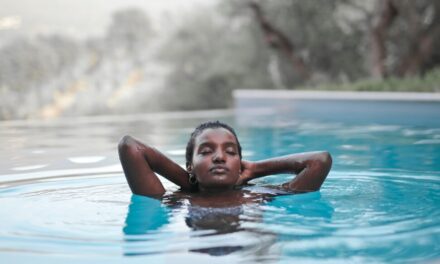I own a lot of bathing suits. I’ve needed them to splash around with my boys when they were toddlers, to join friends in a hot tub or just to maintain a “looking cute while poolside” lifestyle.
Recently though, the only suit I reach for is a black one-piece, now bleached gray from frequent use. It’s cut low on the leg and high across my chest, with skinny straps and lined cups. “Functional” may be the most flattering descriptor. As a woman in her forties finally learning to swim, cuteness is no longer the priority.
I was 42 when I stepped off the pool loungers and into the water. After a failed attempt at learning in my twenties, I’d resigned myself to being land-bound, but then motherhood happened. “Why do you always stay on the sand when Appa takes us snorkeling?” my seven-year-old asked while on vacation a few years ago. “I learned, so why can’t you?” None of my sputtered responses sounded genuine. Finally, inspired by a friend who had also arrived late to swimming, I stopped making excuses and filled out a registration form for lessons.
More From Good Housekeeping

It’s been a year since I began my reintroduction to the pool. Most days, I practice next to a group of seniors who flex their foam dumbbells to Rihanna’s “We Found Love” in joyful synchronicity. My left foot can be disobedient, dragging through the water like a weighted anchor. My right shoulder is prone to stiffness, often sending my body careening towards the lane line. My instructor — her rare smiles like benedictions — says swimming is all about the balance between holding tight and letting go. I adjust my goggles and wonder whether her tone sounds sympathetic or accusatory.
Despite the challenges of learning to swim at this point in my life, the primary emotion that bubbles to the surface each time I get in the pool is exhilaration. Through countless conversations with friends, family and even near-strangers sharing my journey, I’ve noticed an interesting pattern. Swimming is such a basic survival skill that I’d assumed my inability would evoke surprise, especially living in the suburbs of San Francisco. And it has — among white people.
But when speaking to women of color like myself, my experience has felt not like the exception, but the norm.
Women of color face myriad barriers to getting in the pool.
The obstacles that keep children of color from swimming are everywhere, especially for girls. As a child growing up in India, I was entrenched in a conservative culture that prized female modesty. Beginning at a young age, girls felt deeply self-conscious about being “scantily clad” or making themselves subjects of the male gaze. In the ’80s and ’90s, wearing a bathing suit in public, even at a pool or beach, was just not something “decent” women did, which seems ironic in my hometown of Chennai, a coastal city. Instead, girls were encouraged to focus on other pursuits — schoolwork, helping around the house or learning more “feminine” activities like classical music, dance or painting.
Anusha Dhasarathy, 45, who learned to swim in her late 30s in Chicago, recalls her own experience of attempting lessons as a child in India. “It was so awkward,” she says. “Each time we entered the pool, you’d see people staring. The sense of stigma was always there.”
For older women from cultures like mine, elevated levels of social stigma can create complete paralysis. Kamala Chandrasekhar, 71, also grew up in Chennai. She describes the very notion of swimming as a child as “an alien concept. I didn’t think of it as something I was prevented from doing,” she says. “I wouldn’t have wanted to learn even if someone offered to teach me.” It wasn’t until she was almost 68 and had moved to the Bay Area that she conquered her fear of water through private swim lessons.
Many people can’t get into pools at all — even stateside.
And then there’s the issue of access. In many countries, pools are few and far between. Hidden behind the glass doors of private clubs or luxury hotels, they restrict their clientele to the wealthy and privileged.
Supaporm Johns, 36, grew up in southern Thailand and says money for classes or pool memberships was not an option for her family. “But we lived near a beach, where we went almost every day. When I was around 10, my mother just threw me into the ocean,” she recounts. “I did nothing that looked like freestyle or breaststroke. I just figured out how to move my body in the water.” Upon moving to the United States as an adult, Johns was amazed by “how much stuff goes into learning to swim in America. We just didn’t have those things.”
I wondered if being unable to swim was an immigrant epidemic, but the more people I spoke to, the clearer it became that minority women born and raised in the United States aren’t exempt. Melizza Rosich now lives in Seattle but grew up in a “traditional, patriarchal Puerto Rican family with clear gender roles” in New York City. Taking the train down to the beach was an elaborate production; just preparing the cooler took hours. None of the women in her family could swim, although the men did. Rosich recalls her brother learning, “you know, informally, through the sink-or-swim method, but nobody thought I needed to learn, too.” And she wasn’t alone; none of her female friends swam either. “We were all poor and Hispanic, with no money for extracurricular activities. The men were raised to do physical things, but the women stayed home.”
“Men don’t seem to experience the same yearning women do for spaces where they’re told they don’t belong,” Dhasarathy posits. “Even when they are new to something, society has trained men to walk in and make themselves at home.”
The United States also has a complicated history with water being a space of equal access. To this day, urban neighborhoods with majority Black and brown populations are likely to have fewer pools. Jeff Wiltse traces the segregationist roots of this phenomenon in his 2010 book, Contested Waters: A Social History of Swimming Pools in America. Under the looming shadow of Jim Crow, many municipal pools in Black neighborhoods were closed. Those that stayed open were appallingly maintained. When Black Americans challenged segregation laws to gain access to mixed community pools, says Wiltse, “White swimmers generally abandoned them for private pools. By the ’70s and ’80s, tens of millions of mostly white middle class Americans swam in their backyards or at suburban clubs,” dividing recreational swimming along racial lines.
The reverberations of this dubious legacy are still apparent. A decade ago, Rebecca Wildman-Tobriner spearheaded a swim club at the Boys and Girls Club in San Francisco, with the goal of making the sport more accessible to minority youth of color, but she found sustaining it to be an uphill battle. “‘There’s a pool here?’ was the most common reaction when we passed out flyers. Nobody knew the facility existed 10 feet away from where they were standing,” she says. Even as the program developed a strong reputation, offering low-cost classes and securing transportation for those who needed it, Wildman-Tobriner admits to a definite lack of interest from the very families she hoped to draw. “I felt like someone who was trying to push this thing on people that they didn’t really want. There’s money in swimming to add more diversity to the sport, but it takes an incredible amount of energy to combat existing stereotypes.”
Lack of water access has real safety ramifications.
Medical research abounds about drowning and water safety concerns among various demographics. The rate of unintentional death by drowning is 50% higher among Black adults in comparison to their white counterparts. Both Black and Hispanic adolescent populations are more likely to engage in risk-taking behavior (such as not wearing life jackets in deep water) even though fewer of them have formally learned to swim.
I can attest to the truth of this data: In my twenties, I zipped myself into a wetsuit for a morning of deep-sea kayaking in Monterey Bay. An hour into the expedition, my kayak flipped over. Luckily, two other family members (both male) were strong swimmers and saved me, but in hindsight I’m alarmed by my own stupidity.
Rosich had a similar experience growing up. “My grandmother would let me go to the beach with family friends,” she said. “I remember a current taking me under a couple of times and somehow managing to not die. I can’t imagine doing the same with my own kids.”
For women of color, like me, having kids of our own can be the turning point that finally drives us to swim lessons. We realize the importance of being able to help our children stay safe in the water, but there are so many more benefits to taking the literal plunge. As a mother whose daily life is filled with the noisy needs of others, swimming has become a place of refuge. When I enter the water, I give up my need for control. I suspend my worries about looking ridiculous. I can release my body into a starfish pose, stare up at the sky and just breathe. Even if I never become an accomplished swimmer, I emerge each time having understood myself better. It’s a way to practice empathy for myself and model it for my children.
Most importantly, learning to swim later in life lets us see our own potential. As Dhasarathy said to me, “Challenging myself physically gave me the courage to try other things, personally but also in my professional life. It wasn’t about the water anymore, swimming became a lesson in conquering fear.” Chandrasekhar agrees. “Learning to swim at 70 allowed me to try things like zip lining that I wouldn’t have otherwise considered. I have confidence now that I never had,” she added. “I used to worry about men staring, but you know what? Let them stare! It’s time women started living for themselves and stopped letting others inhibit them.”
Freelance Writer
Purnima Mani’s writing covers the intersection of parenting, education, food and immigrant life. She lives in Northern California with her husband, two children and one very opinionated rescue dog.





